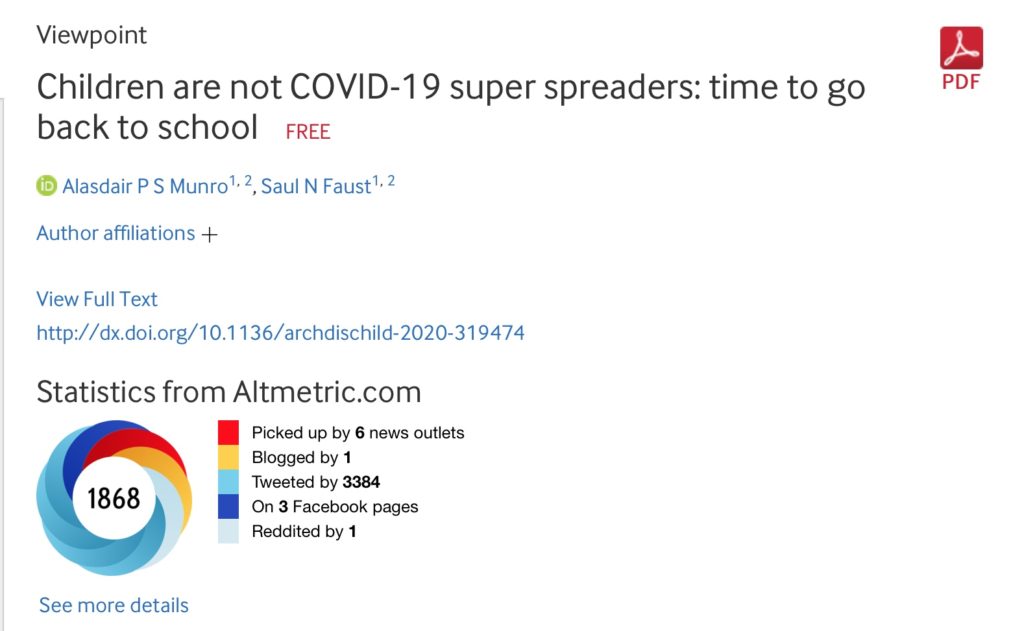Posted 21 May 2020

I was asked today if I had any views on the plans for some years groups of children to return to school at the beginning of June.
The ‘back to school’ issue is a biggie because it sort of echoes all our concerns about coming out of lockdown. It is like our children (and their teachers) are a sub-population and we are asking them to dip their toes in the water first. To be our first out of lockdown guinea pigs.
As I do not have children, it is easy for me to look the other way.
To contribute though, I have just found a paper in the BMJ with the title: “Children are not COVID-19 super spreaders: time to go back to school”. From the title alone, I know which side of the fence the authors’ views have fallen!
Both authors are funded by the National Institute for Heath Research: I do not know if this body has any stance or affiliation to either side in the debate on re-opening schools.
Before I delved into the paper, the two pre-existing thoughts I had were:
1) Children seem to have much lower case rates in the current pandemic than adults and comprise a lower percentage of COVID19 cases than they typically would of say, influenza cases. But is this apparent low case rate due to children not becoming infected or rather because, if they do become infected they are more likely to be asymptomatic and therefore less likely to be tested? Effectively, by that latter question I am suggesting that there could be more childhood cases, but they are just not being picked-up.
2) Children are normally significant contributors to the spread of other infections and usually are key drivers of household infections. Is there any evidence this is less the case for COVID19?
So into the paper.
The paper cites an early study from China suggesting that children did appear to have a role in COVID19 transmission. However, later studies that have used community PCR testing (so swab testing for the RNA of the virus conducted on samples of the population rather than just at point of entry in the medical system) and have shown children are indeed less likely to be infected.
Testing in Iceland – this country has conducted more PCR tests per head of population than any other country – showed that whereas 14% of adults admitted to hospital had a positive PCR result, only 6% of children admitted gave positive results. In community testing, that is people invited in for testing, no children under 10 were found PCR positive, compared to 0.8% of the general population.
In the town of Vo, Italy, 86% of all inhabitants were screened and similarly no children under the age of 10 were found to be positive; 2.6% of the general population were positive. Many of the tested children lived with adults who tested positive but that did not increase the children’s chances of testing positive.
Contact tracing data from Japan and China shows children have a much lower attack rate (likelihood of contracting the infection) than adults. The China data suggested a ratio of one fifth compared to adults over 60.
All those data point to children genuinely being less likely to develop the infection.
The paper then turns to data on children transmitting the infection.
Collated contact tracing studies from Europe have shown children being responsible for only 10% of household clusters of infection (where one household has more than one infection case). Similar studies in Guangzhou found children only responsible for 5% of domestic clusters. One contract tracing datum showed that an infected child in the French Alps did not transmit the infection to another person even though that child had exposure to more than one hundred other children in a school and the ski resort. In a school in NWS Australia, from nine child and nine adult initial infection cases, none of the other 735 students or 128 staff contracted the infection. A study from the Netherlands also showed zero transmission from child to adult in a school environment.
The paper does caution slightly that there can be reliability issues with swab collection from children but counters that the consistency of the data from different countries and sampling methods, do all point to reduced transmission from children. Until robust and comprehensive sero-surveillance is conducted (looking for the adaptive immune response to the virus) the picture may not be known fully.
The authors though consider the PCR data so far strongly suggestive that children are not super-spreaders of the infection (hence the title of the paper!)
A UNESCO report on the education disruption caused by the COVID19 response, suggests: “The risks of COVID transmission in children are low. Children’s education and their wellbeing is – and should be – a priority. Prolonged lockdown of schools penalises an entire global cohort. It incentivises excessive reliance on electronic means of communication and a sedentary lifestyle. “
Maybe it becomes yet another issue of balancing risks. No endeavour is risk-free. The risk to childhood development from prolonged disruption to school routine almost certainly out-weighs the COVID19 risk to the children. The risk to adults in the school environment is different and safeguarding those adults at high risk with co-morbidities may be sensible. Elderly relatives of school-aged children should continue to be safeguarded as currently.
